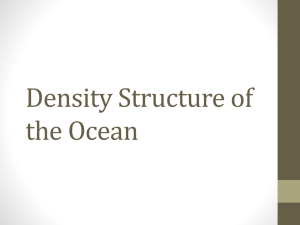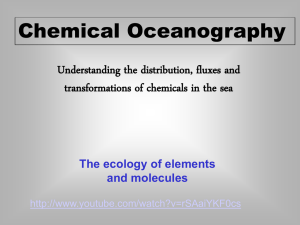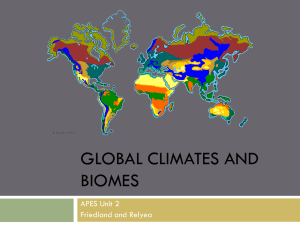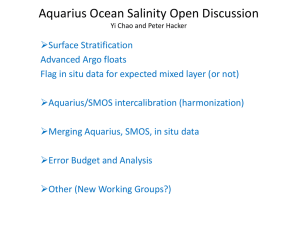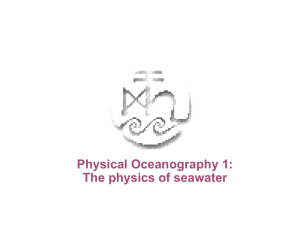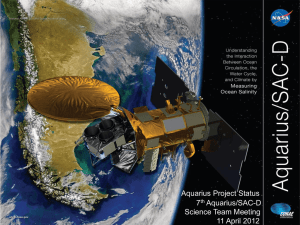Don`t Forget the Salt! - COSEE Ocean Systems
advertisement
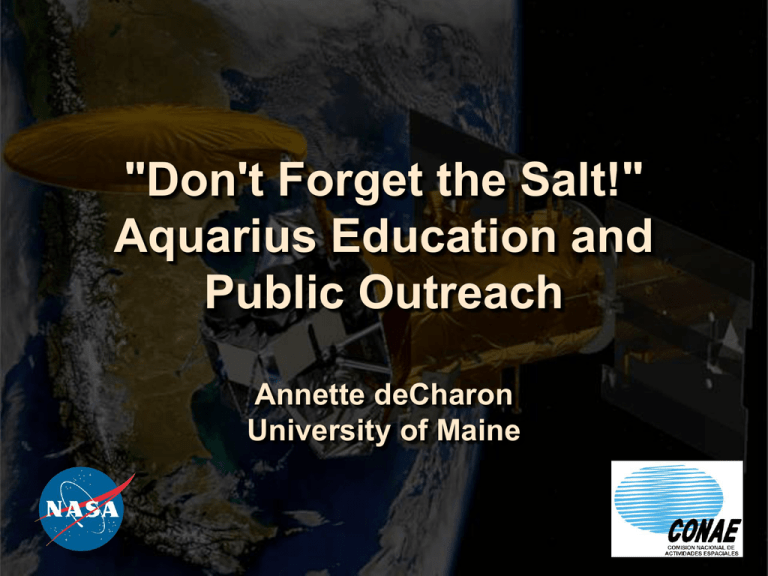
"Don't Forget the Salt!" Aquarius Education and Public Outreach Annette deCharon University of Maine This map shows a sevenday average, based on all known measurement locations sampled over the past 100 years for Sea Surface Salinity (SSS) http://www.youtube.com/watch?v=nb7KAf-HsE8 Not presently measured by satellite, this map shows the weekly SSS coverage that will be achieved by Aquarius after it is activated Aquarius / SAC-D is a joint U.S. (NASA) - Argentine (CONAE) venture How do we engage today’s learners to utilize SSS data sets? By providing resources that demonstrate how improved understanding of salinity patterns – with ties to climate and the water cycle – can benefit society as a whole. K-4: Explain that evaporation can separate the water from the salt in salt water 5-8: Explain how the processes of the water cycle relate to the ocean Salinity patterns are governed by geographic differences in the "water budget." Students learn about the processes that influence salinity patterns using sequential maps of monthly mean data from the North Atlantic Ocean. http://aquarius.nasa.gov/education-datatools.html By clicking on the "play" button, users view pairs of monthly maps. On a data analysis worksheet, students answer a series of "Key Questions": What is the environmental significance of the "0" line on the E-P map? By clicking on the "play" button, users view pairs of monthly maps. On a data analysis worksheet, students answer a series of "Key Questions": What is the environmental significance of the "0" line on the E-P map? By clicking on the "play" button, users view pairs of monthly maps. On a data analysis worksheet, students answer a series of "Key Questions": What is the environmental significance of the "0" line on the E-P map? By clicking on the "play" button, users view pairs of monthly maps. On a data analysis worksheet, students answer a series of "Key Questions": What is the environmental significance of the "0" line on the E-P map? By clicking on the "play" button, users view pairs of monthly maps. On a data analysis worksheet, students answer a series of "Key Questions": What is the environmental significance of the "0" line on the E-P map? By clicking on the "play" button, users view pairs of monthly maps. On a data analysis worksheet, students answer a series of "Key Questions": What is the environmental significance of the "0" line on the E-P map? By clicking on the "play" button, users view pairs of monthly maps. On a data analysis worksheet, students answer a series of "Key Questions": What is the environmental significance of the "0" line on the E-P map? By clicking on the "play" button, users view pairs of monthly maps. On a data analysis worksheet, students answer a series of "Key Questions": What is the environmental significance of the "0" line on the E-P map? By clicking on the "play" button, users view pairs of monthly maps. On a data analysis worksheet, students answer a series of "Key Questions": What is the environmental significance of the "0" line on the E-P map? By clicking on the "play" button, users view pairs of monthly maps. On a data analysis worksheet, students answer a series of "Key Questions": What is the environmental significance of the "0" line on the E-P map? By clicking on the "play" button, users view pairs of monthly maps. On a data analysis worksheet, students answer a series of "Key Questions": What is the environmental significance of the "0" line on the E-P map? By clicking on the "play" button, users view pairs of monthly maps. On a data analysis worksheet, students answer a series of "Key Questions": What is the environmental significance of the "0" line on the E-P map? Hands on experiments Salinity difference (35 ppt) 9-12: Explain the influence of ocean salinity on the thermohaline circulation (e.g., “global conveyer belt”) Temperature difference (30 deg C) Karp-Boss et al. (2009) http://tos.org/hands-on/teaching_phys.html Visualizations Density Thermohaline circulation http://aquarius.gsfc.nasa.gov/gallery-animations.html NASA Scientific Visualization Studio Advanced students can use interactive tools to explore historical salinity, temperature & density data from the World Ocean Atlas (2005). Guided by a "Q & A" format, users can create maps, in-water profiles & time-series graphs. Direct links to Interactive Tools & Tutorials http://aquarius.jpl.nasa.gov Annual mean maps & In-water profiles: Salinity, temperature & density Annual mean maps & In-water profiles: Salinity, temperature & density Annual mean maps & In-water profiles: Salinity, temperature & density Annual mean maps & In-water profiles: Salinity, temperature & density Can choose up to six locations at once Annual mean maps & In-water profiles: Salinity, temperature & density Annual mean maps & In-water profiles: Salinity, temperature & density Annual mean maps & In-water profiles: Salinity, temperature & density Advanced students can use interactive tools to explore historical salinity, temperature & density data from the World Ocean Atlas (2005). Guided by a "Q & A" format, users can create maps, in-water profiles & time-series graphs. Direct links to Interactive Tools & Tutorials http://aquarius.jpl.nasa.gov Monthly mean maps & Time-series graphs Salinity, Temperature & Density from 1 - 6 depths Monthly mean maps & Time-series graphs Salinity, Temperature & Density from 1 - 6 depths Monthly mean maps & Time-series graphs Salinity, Temperature & Density from 1 - 6 depths Monthly mean maps & Time-series graphs Salinity, Temperature & Density from 1 - 6 depths Monthly mean maps & Time-series graphs Salinity, Temperature & Density from 1 - 6 depths Monthly mean maps & Time-series graphs Salinity, Temperature & Density from 1 - 6 depths Interactive tools include annual salinity, temperature, and density data (1800-2005) to answer these questions: Were the oceans as salty a hundred years ago? Can we answer that question? Why do we care? http://aquarius.jpl.nasa.gov/ Quick link to climate data “Student outcomes” resources database (examples) Grades K-4 Grades 5-8 Grades 9-12 Water Cycle Explain that evaporation can separate the water from the salt in salt water Explain how the processes of the water cycle relate to the ocean Explain relationships between fresh water & ocean dynamics Ocean Circulation Describe connections Explain the effect of between ocean salt water density on ocean & fresh water in water cycle circulation Explain the influence of ocean salinity on the thermohaline circulation Climate Compare climates based on precipitation, temperature & distance from ocean Explain the ocean holds a large amount of heat & its effect on climate Describe how changes in ocean circulation can produce changes in climate 21st Century Technology Explain that satellites can make measurements at a distance Gather, analyze & interpret data about the ocean’s effects on climate Explain how technology can enhance the gathering & use of oceanic data http://aquarius.nasa.gov/education-outcomes.html Where can you find these tools & resources? http://aquarius.nasa.gov/education.html For more information, please contact: Annette deCharon <annette.decharon@maine.edu> Thank you!
